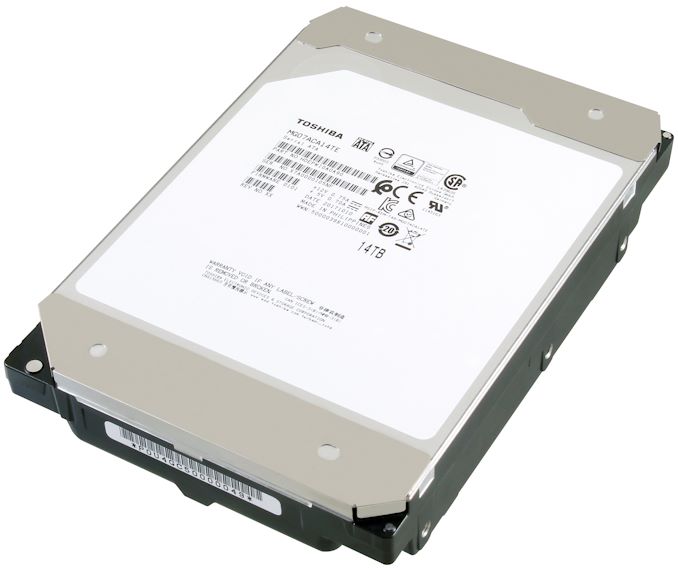18 TB HDDs: Toshiba Collaborates with Showa Denko for MAMR HDDs
by Anton Shilov on February 22, 2019 3:00 PM EST- Posted in
- HDDs
- Storage
- Toshiba
- MAMR
- Helium HDD
- Showa Denko
- SDK

Showa Denko K.K. (SDK) announced on Thursday that it had completed the development of its microwave assisted magnetic recording (MAMR) platters for next-gen hard drives. The company is set to ship platters to Toshiba, which plans to start sampling of its new 18 TB nearline HDDs later this year. In addition to MAMR media, Showa also plans to release disks based on the heat assisted magnetic recording (HAMR) technology in the future.
The new 3.5-inch platters from SDK feature a 2 TB capacity and a new magnetic recording layer whose coercivity can be lowered using microwaves (see our brief description of the MAMR technology). SDK is not specifying which magnetic alloy or substrate it's using for its 2 TB media, but according to Western Digital, both should be very similar to those used for today’s platters based on the perpendicular magnetic recording (PMR) technology. Which for Toshiba and its consumers means predictable pricing and reliability.
SDK says that Toshiba is set to use nine 2 TB platters for its 18 TB MAMR-based nearline HDDs, which will begin sampling later this year (and which will probably be commercially available in 2020). That said, it looks like the MAMR disks from Showa may be based on the company’s latest aluminum substrates, which allows for building 0.635 mm thick PMR media today (keep in mind that this is not an official confirmation, but rather an educated guess).
Being a supplier of HDD platters, Showa Denko naturally does not disclose any details about Toshiba’s nine-platter 18 TB HDD itself. While increased areal density will inevitably improve its maximum sustained transfer rate compared to existing 7200 RPM hard drives, its IOPS per terabyte performance is something that remains to be seen. If the HDD platform keeps using one actuator, then Toshiba will have to heavily tune its firmware to deliver the kind of IOPS per terabyte performance that its customers require (read more about this here)
Showa Denko also said that in addition to its MAMR media, it is on-track to supply HAMR-based platters when their time comes. Unfortunately, it did not disclose its exact timeline for HAMR disks, but only reassured investors the tech is on the road towards commercialization.
Related Reading:
- 16 TB MAMR Hard Drives in 2019: Western Digital
- Western Digital Stuns Storage Industry with MAMR Breakthrough for Next-Gen HDDs
- HOYA Starts to Build Next-Gen HDD Glass Substrate Production Facility
- State of the Union: Seagate's HAMR Hard Drives, Dual-Actuator Mach2, and 24 TB HDDs on Track
Source: Showa Denko










7 Comments
View All Comments
baka_toroi - Friday, February 22, 2019 - link
Keep on chugging on, magnetic media!Lord of the Bored - Saturday, February 23, 2019 - link
The disk will never stop spinning!nathanddrews - Friday, February 22, 2019 - link
10c/GB SSDs and 15TB+ HDDs... 2019 is an exciting year for storage.spaceship9876 - Saturday, February 23, 2019 - link
I hope someone makes a 2TB and 4TB drive using these 2TB platters.close - Saturday, February 23, 2019 - link
They might not for quite a while. The speeds for 9 times less platters will not be impressive. Also the price does not decrease linearly with the reduced number of platters. The end result will be a very slow, (very) low capacity, and relatively expensive drive. Doesn't sound too competitive.Spinning disks compete on capacity and price per GB. This calls for big drives.
piroroadkill - Sunday, February 24, 2019 - link
Any heat or microwaved assisted drives are going to be so costly. Already the difference from 10TB to 12TB is enormous (almost double the cost from the cheapest 10TB to the 12TB that I could find), so going with anything larger than 10TB doesn't make any sense.Supercell99 - Sunday, February 24, 2019 - link
How many hours would it take to download all that data? Not just the port speed but the IOPS? Seems like the capacity is outgrowing the usefulness of the interface/medium.